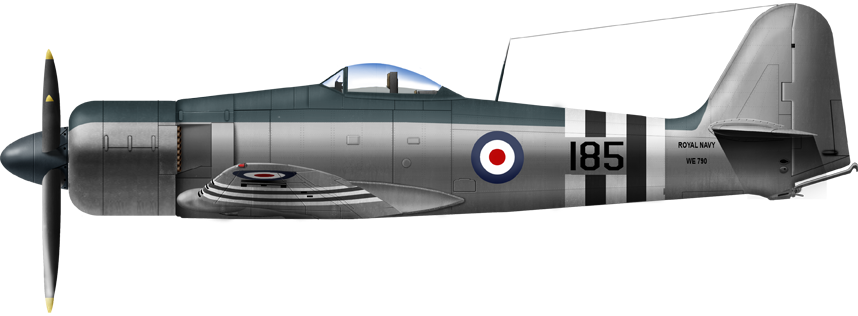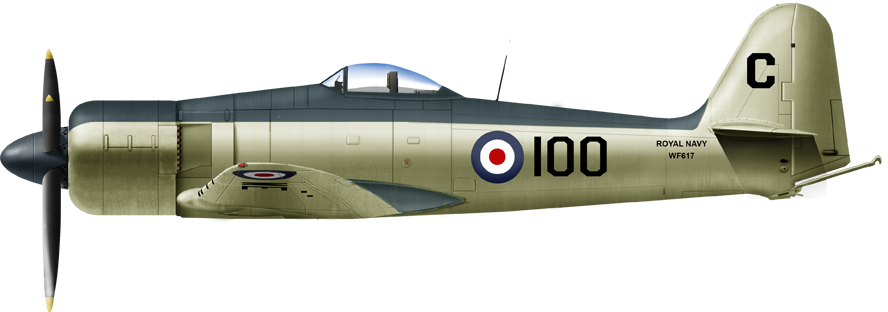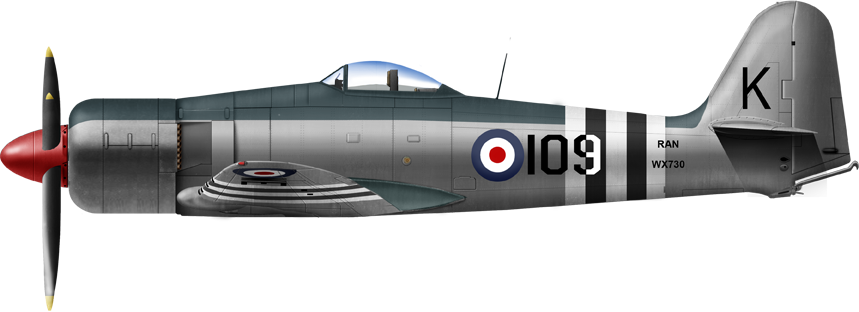Not a navalized Tempest

The Hawker Sea Fury was a brillant machine, and a replacement, more than a development of the land-based Hawker Tempest. The Sea Fury really was the last piston-engine model to enter service with the RN, boasting even with the full additional ordinance, a top speed of 460 mph and 20,000 feet climbed in just under five minutes, while staying very agile.
It was almost overpowered with a 3,000 hp (2,200 kW) Bristol Centaurus engine coupled to a five-bladed propeller. If the Tempest was rugged, the Sea Fury was even sturdier, but also more compact and lighter. It was comparable in a sense to the Grumman Bearcat. From 1948, the Sea Fury entered service on nearly all light fleet carriers completed and those not yet leased or transferred, and saw plenty of action in Korea. A superb machine, production only stopped in 1955 and it served until 1968 in the Malay air Force among others.
❮❮❮❮❮❮❮❮❮❮❮
⚠ Note: This post is in writing. Completion expected in late 2023.
❯❯❯❯❯❯❯❯❯❯❯
Development
In 1942, Sydney Camm began work on a replacement for the Hawker Typhoon. The idea was to achieve better performance by keeping the same engine but making the rest of the aircraft smaller and lighter. The drawings were presented in January 1943 to the Air Ministry who ordered six prototypes with three different engine options; Rolls-Royce Griffon, Napier Saber and Bristol Centaurus.In April of the same year, Hawker received a specification from the Admiralty for a similar aircraft for the Royal Navy and development was then also focused on a naval variant. By April 1944, 200 Furys were under contract for the RAF and a further 200 Sea Furys for the RN (of which 100 were to be manufactured by subcontractor Boulton Paul).
On 1 September 1944, the first prototype flew with a Centaurus XII engine and four-bladed propeller, followed on 27 November by the second prototype with a Griffon engine and twin counter-rotating propellers. The sixth and final prototype flew on 25 July 1945 with a Saber VIII engine of over 3,000 horsepower and managed to reach 780 kph. The end of the Second World War meant that the air force canceled its aircraft and chose to invest entirely in jet-powered aircraft instead. In addition, deliveries of the RAF's last propeller-driven fighter, the Supermarine Spiteful, had already begun. The fleet chose the opposite path.
As the Fury exhibited better low-speed characteristics than the Supermarine Seafang, and thus was better suited to landing on aircraft carriers, it was decided to proceed with the SeaFury as a safer conventional alternative to the Sea Vampire. The Sea Fury was tested and qualified for sea service on HMS Victorious during 1946 and entered service in February 1947.
Design specifics
General conception
Engine
Armament
Specifications | |
| Crew: | 1 pilot |
| Lenght | 34 ft 8 in (10.57 m) |
| Wingspan | 38 ft 4.75 in (11.7031 m) |
| Height | 15 ft 10.5 in (4.839 m) |
| Wing area: | 280 sq ft (26 m2) |
| Empty weight | 9,240 lb (4,191 kg) |
| Gross Weight | 12,350 lb (5,602 kg) |
| Max TO Weight | 14,650 lb (6,645 kg) |
| Propulsion: | 1× Bristol Centaurus 18 18-cyl. air-cooled radial 2,480 hp (1,850 kW) |
| Propeller: | 5-bladed constant-speed propeller |
| Performances: | 460 mph (740 km/h, 400 kn) at 18,000 ft (5,500 m) |
| Service ceiling: | 35,800 ft (10,900 m) |
| Rate of climb: | 4,320 ft/min (21.9 m/s) |
| Range: | 780 mi (1,260 km, 680 nmi) |
| Ferry range: | 904 mi (1,455 km, 786 nmi) with two drop tanks |
| Gun Armament | 4× 20 mm (0.79 in) Hispano Mk V autocannon |
| Armament underwing | 16 × 3 inch rockets, 2,000 lb (910 kg) bombs |
Variants
F.10 – First production series made for the Royal Navy. 50 built.FB.11 – Second production series of weapon beams for bombs or rockets. 615 built including 31 for Australia and 53 for Canada.
T.20 – Two-seater school version. 61 built.
F.50 – Export version equivalent to F.10 for the Netherlands. 10 built.
FB.51 – Export version equivalent to FB.11 for the Netherlands. 25 built.
FB.60 – Export version. 93 built for Pakistan and 12 for the Netherlands.
T.61 – Two-seater school version for Pakistan. 5 built.
Fury I – Land-based version without folding wings and landing gear. 55 built for Iraq.
Fury Trainer – Two-seater school version of the Fury I. 5 built.
Royal Navy service
hhhhhhhhhhh A Sea Fury loaded with rockets takes off from the aircraft carrier HMS Glory in June 1951.The Sea Fury replaced the Supermarine Seafire as the primary fighter aircraft of the Royal Navy. The Seafire was an emergency solution pushed forward by the demands of the war as a replacement for the hopelessly outdated Gloster Gladiator. The Seafire's long nose gave poor forward visibility and the narrow landing gear made landing at sea a challenge. The Sea Fury was faster than the Seafire, had a longer range and could also be used as an attack aircraft armed with bombs or rockets.
During the Korean War, Sea Furies were deployed from the aircraft carriers HMS Glory, HMS Theseus and HMS Ocean beginning in October 1950. During December, 332 attacks on bridges, railways and airfields in North Korea were carried out by the Sea Fury. During 1952, Chinese MiG-15s began to appear over Korea. On 8 August 1952, eight MiG-15s attacked a British formation of Sea Furies and Fireflies. In the battle, a Firefly was seriously damaged while a MiG-15 was shot down by a Sea Fury. It was the only British air combat victory of the Korean War.
The Sea Fury began to be replaced by the Hawker Sea Hawk and Supermarine Attacker in 1953 and in August 1955 the last was withdrawn from service. Since 1971, the Royal Navy Historic Flight has had a few Sea Furies in service. Unfortunately, several of them have been destroyed or damaged in accidents.
Other users
Australia: The RAAF
Australia was an early export customer of the Sea Fury. The plan entered service with the Australian Navy in 1948 and was used by three divisions (No.805, No.808 and No.850 Squadron) aboard the aircraft carriers HMAS Sydney and HMAS Vengeance. Like Britain, Australia used its Sea Furies in the Korean War. Australia kept them in service until 1962.[6][7]Burma
In 1957, Burma purchased twenty-one second-hand Sea Fury from Great Britain. They were deployed against Kuomintang-backed guerrillas in northern Burma. On February 15, 1961, a Taiwanese Consolidated Privateer was shot down by Sea Fury planes near the Thai border, as it was suspected of delivering supplies to the guerrillas. Burma replaced its Sea Furies with Lockheed T-33 Shooting Star aircraft in 1968.Canada
Another early adopter of Sea Fury was Canada. The first aircraft was delivered in June 1948. Two divisions (No.803 and No.883 Squadron, later renamed No.870 and No.871 Squadron) operated the aircraft from the aircraft carrier Magnificent and from Shearwater Air Force Base in Nova Scotia. The Sea Fury was used until 1956 when the model was replaced by the McDonnell F2H Banshee.Cuba
A Cuban Sea Fury on display at Playa Girón at the Bay of Pigs in Matanzas. In the context of the 1959 Cuban Revolution, Fulgencio Batista's government purchased seventeen used Sea Fury from Britain to fight the 26th of July Movement. However, it wasn't long before Batista was overthrown and the planes were taken over by the Cuban Revolutionary Air Force. Due to a lack of spare parts and flight mechanics, only five were in airworthy condition by April 1961. Two of them were destroyed on the ground on 15 April by Douglas A-26 Invaders. The day after the Bay of Pigs invasion began, the remaining aircraft of the Revolutionary Air Force attacked the invasion force and sank the ships Houston and Rio Escondido. At least one Douglas Invader was also shot down by Sea Furies. One Sea Fury crashed in the Bay of Pigs due to engine failure, probably caused by anti-aircraft fire.Netherlands (Air Force and Navy)
In April 1948, the Netherlands purchased twenty-two Sea Furys from Hawker as well as a license for Fokker to manufacture an additional 25 aircraft. These were based on the aircraft carrier Hr.Ms. Karel Doorman (ex HMS Venerable). They were replaced in 1957 by the jet-powered Hawker Sea Hawk.Iraq
The first export customer to order the Sea Fury back in 1946 was Iraq and it was also Iraq that requested the development of a two-seater school version. Deliveries began in 1947 but were halted during the 1948 Arab-Israeli War when Iraqi Sea Furies based in Egypt were deployed against Israel. The remaining Sea Furies ordered by Iraq were instead delivered to Pakistan. After the war, Iraq placed two new orders for Sea Furies; fifteen new-built in 1951 and ten second-hand in 1953. They were replaced by the Hawker Hunter in the 1960s.Pakistan
During the Indo-Pakistani War of 1947, Pakistan hurriedly bought fifty Sea Fury planes to supplement its Hawker Tempests. After the war, thirty-seven Sea Furies manufactured for Iraq were also purchased, making Pakistan the largest user of the Sea Fury after Britain. Pakistan replaced most of its Sea Fury with the North American F-86 Saber in 1955. Only one division (No.14 Squadron) retained them until 1960 when they were replaced by aircraft of the Lockheed F-104 Starfighter model. Unlike many other countries, Pakistan did not scrap its Sea Furies, but mothballed them to sell on the civilian market during the 1970s. Many of the Sea Furies still airworthy today are ex-Pakistani or Iraqi.Sources/read more
Books
Links
On WikipediaThe model corner
Gallery
Author's illustrations: Types and liveries

Hawker Sea Fury, Suez crisis 1956

Sea Fury 810 NAS HMS centaur Korea 1950

Hawker Sea Fury Fb.Mk.11 805 NAS HMAS Sydney Korea 1951
Photos
- Lohner E (1913)
- Macchi M3 (1916)
- Macchi M5 (1918)
- Ansaldo ISVA (1918)
- Sopwith Baby (1916)
- Short 184 (1916)
- Fairey Campania (1917)
- Sopwith Cuckoo (1917)
- Felixstowe F.2 (1917)
- Friedrichshafen FF 33 (1916)
- Albatros W4 (1916)
- Albatros W8 (1918)
- Hanriot HD.2
- Grigorovitch M5
- IJN Farman MF.7
- IJN Yokosho Type Mo
- Yokosho Rogou Kougata (1917)
- Yokosuka Igo-Ko (1920)
- Curtiss N9 (1916)
- Aeromarine 39
- Vought VE-7
- Douglas DT (1921)
- Boeing FB.5 (1923)
- Boeing F4B (1928)
- Vought O2U/O3U Corsair (1928)
- Blackburn Blackburn (1922)
- Supermarine Seagull (1922)
- Blackburn Ripon (1926)
- Fairey IIIF (1927)
- Fairey Seal (1930)
- LGL-32 C.1 (1927)
- Caspar U1 (1921)
- Dornier Do J Wal (1922)
- Rohrbach R-III (1924)
- Mitsubishi 1MF (1923)
- Mitsubishi B1M (1923)
- Yokosuka E1Y (1923)
- Nakajima A1N (1927)
- Nakajima E2N (1927)
- Mitsubishi B2M (1927)
- Nakajima A4N (1929)
- CANT 18
WW1
✠ K.u.K. Seefliegerkorps:
 Italian Naval Aviation
Italian Naval Aviation
 RNAS
RNAS
 Marineflieger
Marineflieger
 French Naval Aviation
French Naval Aviation
 Russian Naval Aviation
Russian Naval Aviation
 IJN Air Service
IJN Air Service
 USA
USA
Interwar
 Interwar US
Interwar US
 Interwar Britain
Interwar Britain
 Interwar France
Interwar France
 Interwar Germany
Interwar Germany
 Interwar Japan
Interwar Japan
 Interwar Italy
Interwar Italy
- Curtiss SOC seagull (1934)
- Grumman FF (1931)
- Curtiss F11C Goshawk (1932)
- Grumman F2F (1933)
- Grumman F3F (1935)
- Northrop BT-1 (1935)
- Grumman J2F Duck (1936)
- Consolidated PBY Catalina (1935)
- Brewster/NAF SBN-1 (1936)
- Curtiss SBC Helldiver (1936)
- Vought SB2U Vindicator (1936)
- Brewster F2A Buffalo (1937)
- Douglas TBD Devastator (1937)
- Vought Kingfisher (1938)
- Curtiss SO3C Seamew (1939)
- Douglas SBD Dauntless (1939)
- Grumman F4F Wildcat (1940)
- F4U Corsair (NE) (1940)
- Brewster SB2A Buccaneer (1941)
- Grumman TBF/TBM Avenger (1941)
- Consolidated TBY Sea Wolf (1941)
- Grumman F6F Hellcat (1942)
- Curtiss SB2C Helldiver (1942)
- Curtiss SC Seahawk (1944)
- Grumman F8F Bearcat (1944)
- Ryan FR-1 Fireball (1944)
- Douglas AD-1 Skyraider (1945)
Fleet Air Arm
- Fairey Swordfish (1934)
- Blackburn Shark (1934)
- Supermarine Walrus (1936)
- Fairey Seafox (1936)
- Blackburn Skua (1937)
- Short Sunderland (1937)
- Blackburn Roc (1938)
- Fairey Albacore (1940)
- Fairey Fulmar (1940)
- Grumman Martlet (1941)
- Hawker sea Hurricane (1941)
- Brewster Bermuda (1942)
- Fairey Barracuda (1943)
- Fairey Firefly (1943)
- Grumman Tarpon (1943)
- Grumman Gannet (1943)
- Supermarine seafire (1943)
- Blackburn Firebrand (1944)
- Hawker Sea Fury (1944)
IJN aviation
- Aichi D1A "Susie" (1934)
- Mitsubishi A5M "Claude" (1935)
- Nakajima A4N (1935)
- Yokosuka B4Y "Jean" (1935)
- Mitsubishi G3M "Nell" (1935)
- Nakajima E8N "Dave" (1935)
- Kawanishi E7K "Alf" (1935)
- Nakajima B5N "Kate" (1937)
- Kawanishi H6K "Mavis" (1938)
- Aichi D3A "Val" (1940)
- Mitsubishi A6M "zeke" (1940)
- Nakajima E14Y "Glen" (1941)
- Nakajima B6N "Jill" (1941)
- Mitsubishi F1M "pete" (1941)
- Aichi E13A Reisu "Jake" (1941)
- Kawanishi E15K Shiun "Norm" (1941)
- Nakajima C6N Saiun "Myrt" (1942)
- Yokosuka D4Y "Judy" (1942)
- Kyushu Q1W Tokai "Lorna" (1944)
Luftwaffe
- Arado 196 (1937)
- Me109 T (1938)
- Blohm & Voss 138 Seedrache (1940)
Italian Aviation
- Savoia-Marchetti S.55
- IMAM Ro.43/44
- CANT Z.501 Gabbiano
- CANT Z.506 Airone
- CANT Z.508
- CANT Z.511
French Aeronavale
- GL.300 (1926-39)
- Levasseur PL.5 (1927)
- Potez 452 (1935)
- Loire 210 (1936)
- Loire 130 (1937)
- LN 401 (1938)
Soviet Naval Aviation
- Shavrov SH-2 (1928)
- Tupolev TB-1P (1931)
- Beriev MBR-2 (1930)
- Tupolev MR-6 (1933)
- Tupolev MTB-1 (1934)
- Beriev Be-2 (1936)
- Polikarpov I16 naval (1936)
- Tupolev MTB-2 (1937)
- Ilyushine DB-3T/TP (1937)
- Beriev Be-4 (1940)
-
Skoda Š-328V
R-XIII Idro
Fokker C.XI W (1934)
WW2
- De Havilland Sea Vixen
- Hawker Sea Hawk
- Supermarine Scimitar
- Blackburn Buccaneer
- Hawker Sea Harrier
- Douglas A4 Skyhawk
- Grumman F9F Panther
- Vought F8 Crusader
- McDonnell-Douglas F-4 Phantom-II
- North Am. A5 Vigilante
- TU-142
- Yak 38 forger
☢ Cold War
✧ NATO
 Fleet Air Arm
Fleet Air Arm
 US Navy
US Navy
☭ Warsaw Pact
Merch

Seafire Mark 45; HMS Pretoria Castle

Zeros vs its aversaries

Aichi D3A “Val” Junyo

Mitsubishi A5M poster

F4F wildcat

Macchi M5

SBD Dauntless Coral Sea

SBD Dauntless USS Enterprise

SBD-4 CV22